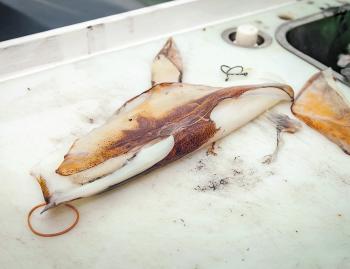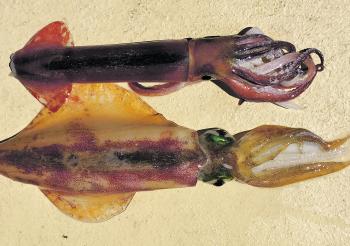Catching squid can be either a means to an end, or a fun and fulfilling sport in its own right. Whatever your motivation, here are some basic tips on how to do it more efficiently.
For many anglers, hunting squid is simply the first step on a path to obtaining either high quality bait, a delicious meal… or possibly both. For others, squidding becomes an addictive passion, just like any other stimulating form of recreational fishing.
Japanese anglers – who refer to the capture of squid on lines and jigs as ‘eg-ing’ or ‘egging’ – have helped to elevate this branch of the sport to new heights right across the globe. In Japan and other parts of Asia, there are regular egging tournaments, as well as publications and video channels devoted solely to the pursuit of these tentacled cephalopods.
This devotion to squid fishing has gradually spread to other parts of the world including Australia and some Victorian anglers, in particular, now take their squidding very seriously indeed. These devotees think nothing of spending hundreds of dollars buying a dedicated squid-catching outfit, nor of amassing collections of squid jigs that would rival those of the keenest lure fishers in both their numbers and value.
Prior to the 1980s, if Aussie fishers pursued squid at all, it was mostly to use as bait. In those days, squid were captured by skewering whole fish such as yellowtail, slimy mackerel, mullet or whiting lengthwise on a metal spike or ‘jag’ that carried a collection of sharp, curved points at one end. This was tied to a line (usually a heavy handline) and lobbed in front of a squid. When the cephalopod wrapped its tentacles around the offering, a pull on the line hopefully secured the catch, allowing anglers to unceremoniously haul it in.
During the last couple of decades of the 20th century, two important changes occurred. Firstly, more Aussies realised just how good squid are to eat. Secondly, we saw the arrival of increasingly sophisticated squid jigs from Asia. These culminated in the cloth-covered, prawn-shaped jigs that nowadays dominate squid fishing globally. It would be an understatement to say that these modern squid jigs have revolutionised the sport.
Naturally, you don’t need dedicated outfits or dozens of expensive jigs to catch a few squid, although having a handful of jigs in different sizes, weights and colours isn’t a bad idea. What you do need is some basic know-how, including an idea of where and when to start looking for squid. That usually boils down to shallower, inshore areas with relatively clean water and a bottom consisting of broken patches of reef, gravel, sand and weed beds, typically within bays, harbours and lower estuaries, but also out to sea and along the coast.
Squid have excellent eyesight. As well as being able to detect a wide range of colours, they can also see polarised light, along with parts of the ultra-violet end of the spectrum that remain invisible to us. They hunt primarily by sight and need to visually detect their prey. They can do this in extremely low-light conditions. In fact, dim lighting favours these hunters, which is why they’re often caught in good numbers at dawn, dusk, at night and under heavy cloud cover. In bright conditions, they’ll typically move to deeper water.
Attach your prawn-style squid jig to a light to medium outfit. Spinning gear or a sidecast is best, but baitcasters work, too. Cast the jig into likely areas, allowing it to sink well down in the water column. Avoid letting the jig drop right to the bottom in snaggy locations. Begin working your jig with a series of slow to medium paced sweeps of the rod, picking up slack line with your reel between sweeps. Try different actions. You can also suspend jigs beneath bobby corks before casting them out and simply leave them to be worked by the swell and chop.
The take of a squid is heralded by a heavy weight coming onto the line, followed by a series of strong pulses as the animal attempts to jet away. Maintain steady pressure and a tight line. Work the squid smoothly towards your boat or the shore and use a landing net to secure larger squid. Oh, and watch out for that final squirt of ink!
Reads: 5049
The southern calamari squid is highly prized by anglers and is capable of reaching a couple of kilos in weight.

The author with a better-than-average squid.

Modern, prawn-style jigs – both cloth-covered and uncovered – have revolutionised squidding. Different colours definitely have their day, and even their hour.

Fresh squid makes great bait!

The author with a brace of calamari pulled from offshore waters.

Arrow squid (top) and southern calamari. Both species respond well to the tactics described here.




